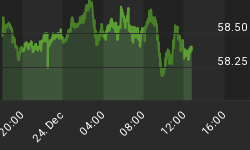Proposed Economic Stimulus Plan May Not Stimulate Much
The new administration is proposing an $825 billion "stimulus" plan. Most of the package is geared toward helping existing or expanded programs such as unemployment assistance, law enforcement, food stamps, etc. Much of this spending will "save" existing jobs or keep existing programs already in place. This may help prevent things from getting worse, but it will offer little in the way of providing new stimulation for the economy. Another large portion of the stimulus plan is in the form of tax cuts. While depreciation incentives may spur some new business spending, credits to individuals may offer little incentive to spend given the state of their balance sheets and concerns about employment. After all the hype about infrastructure spending, only about 25% of the package is geared toward this area.
Tug of War Between Liquidity and Economic Weakness
The chart below was created on the website of the Federal Reserve Bank of St. Louis. It shows the eye-popping expansion of the money supply as financial institutions have swapped securities and other "assets" for cash via borrowing from the Federal Reserve. Borrowing prior to this crisis is barely visible on the graph. Recent borrowing is an extreme example of the term "spike" on a graph. Despite the never before seen tapping of the Fed, financial assets show little evidence of reflation taking place.

U.S. Stocks: Downtrend Remains In Place
If you compare the long S&P 500 ETF (SPY) to the short S&P 500 ETF (SH), it is clear the short side of the market is in better shape. There is little in the way of fundamentals, except hope of government bailouts, to expect any change to these trends.

Recent weakness in the S&P 500 Index leaves open the possibility that we will revisit the November 2008 lows around 740 (intraday). If those lows do not hold, a move back toward 600 becomes quite possible. On Friday (1/23/09) the S&P 500 closed at 832. A drop back to 740 is a loss of 11%. A move back to 600 would be a drop of 28%. These figures along with the current downtrend highlight the importance of principal protection and hedging strategies. SH, the short S&P 500 ETF, can be used to protect long positions or to play the short side of the market.

Gold & Gold Stocks: Moves Impressive, But Still Face Same Hurdles
Friday's big moves in gold (GLD) and gold mining stocks (GDX) have some calling a new uptrend. While recent moves have been impressive some hurdles remain.

Gold stocks (GDX) look a little stronger than gold, but any entry in the market should be modest in size. If $38.88 can be exceeded, our confidence would increase and possibly our exposure.

Run In Treasuries Is Long In The Tooth
Investments with the highest probability of success are those with positive fundamentals and positive technicals. Conversely, the least attractive investments have poor fundamentals and poor technicals. With the U.S. government issuing new bonds at an alarming rate, a continued deterioration in the technicals could signal the end of the Treasury bubble.

TBT offers a way to possibly profit from the negative forces aligning against U.S. Treasury bonds.

Strength In Bonds Shows Little Fear of Price Inflation
The government's policies are attempting to stem the tide of falling asset prices. They hope to reinflate economic activity along with asset prices. The charts here show:
- A weak stock market (see SPY above), and
- An improvement in many fixed income investments (below: LQD, AGG, BMT, PHK, and AWF).
Weak stocks and stronger bonds tell us the government's reflation efforts are thus far not working. If concerns about deflation remain more prevalent than concerns about inflation, fixed income assets may offer us an apportunity. With money markets, CDs, and Treasuries paying next to nothing, we may be able to find improved yields in the following:
- LQD - Investment Grade Corporate Bonds
- AGG - Investment Grade Bonds - Diversified
- BMT - Insured Municipal Bonds
- PHK - High Yield Bonds
- AWF - Emerging Market Government Bonds
With the economy in a weakened and fragile state, we need to tread carefully in these markets. Some key levels which may improve the odds of success are shown in the charts below. Erring on the side of not taking positions is still prudent. The markets remain in a "prove it to me" mode where we would like to see the markets move through key levels before putting capital at risk.





U.S. Dollar Remains Firm
From a technical perspective, the dollar continues to look strong. Its strength supports the continuation of concerns about deflation, rather than inflation. With a rapid expansion of the money supply along with large increases in government liabilities, future dollar weakness is almost a certainty.

















